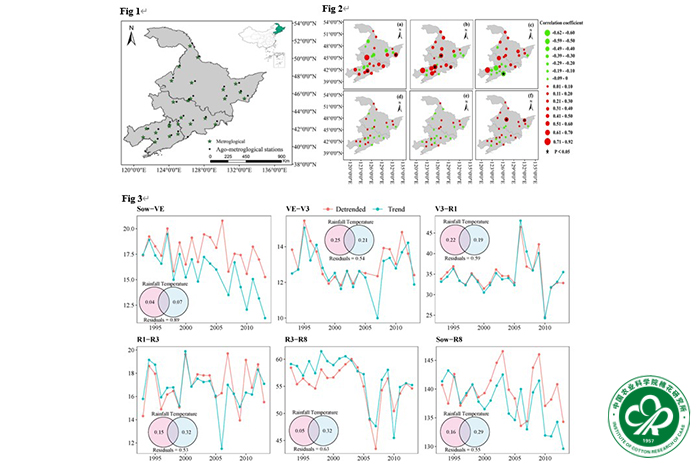- Location : Home» Newsroom
Yabing Li researcher team of Institute of Cotton Research of Caas revealed the mechanism of planting date affecting the within-boll yield components of wheat-cotton double-cropping system
Recently, the team of researcher Yabing Li from the Institute of Cotton Research of Caas conducted a study on the influence of planting date on the cotton boll yield components under the wheat-cotton double-cropping system and revealed the variations of the cotton within-boll yield components at different planting dates under the wheat-cotton double-cropping system. The study found that when the planting date was delayed, cotton yield gradually decreases. The difference in cotton yield of different planting dates can be explained by the cotton boll internal yield components. This study provided new theoretical basis for explore the reasons for the difference in cotton yield at different planting dates under the wheat-cotton double-cropping system. The relevant research results were published in the authoritative international academic journal "Field Crops Research" under the title "Changes in within-boll yield components explain cotton yield and quality variation across planting dates under a double cropping system of cotton-wheat" (Q1, IF=6.145, TOP of Agriculture and Forestry Science).
With the transfer of Chinese main cotton-producing areas to Xinjiang, the wheat-cotton double-cropping system has become the most important cotton planting system in the Yellow River Basin. The wheat-cotton double-cropping system can ensure food security while stabilizing cotton production. However, in the practice of wheat-cotton double-cropping system in the Yellow River Basin, the selection of the appropriate planting date for cotton is still controversial. Cotton yield is determined by the yield components of the whole plant and the within-yield components. Adjusting the planting date affects the growth period of cotton and the utilization of meteorological resources, which in turn will lead to differences in cotton yield components. Currently, there is little information on within-boll yield components differences related to planting date. Studying the within-boll yield components at different planting dates under the wheat-cotton double-cropping system is conducive to more in-depth exploration of the impact of sowing date on cotton yield differences.
This study studied the differences in within-boll yield components at different planting dates under the wheat-cotton double-cropping system, and analyzed their relationship with yield and contribution to yield differences. It was found that at the canopy level, the number of bolls per unit area has an important impact on yield. The largest contribution to the difference (75.6~90.8%), at the within-boll level, the fiber weight per seed (11.2~18.2%) and the number of fibers per unit seed surface area (11.9~16.2%) contributed the most to the yield difference. Compared with PDMay10, the cotton lint yield of PDMay20, PDMay30 and PDJun10 decreased by 3.8%, 14.7% and 44.1% respectively. Changes in within-boll yield components could explain the significant decrease in lint yield. Under the local wheat-cotton double-cropping system, cotton should be sown before June. This research is an important practice in climate-smart agriculture. It provides a new theoretical basis for the formation mechanism of cotton yield differences at different sowing dates under the wheat-cotton double-cropping system. It is important for the selection of suitable sowing dates for the double-cropping wheat-cotton system in the Yellow River Basin. reference value.
This research was supported by the National Key Research and Development Program (2018YFD1000900). Simeng Guo, a master's student in the School of Agriculture of Zhengzhou University, is the first author of the paper. Researcher Yabing Li and associate researcher Lu Feng Institute of Cotton Research of Caas are the corresponding authors of the paper. Master's student Fengxi Wu also participated in the research. The National Key Laboratory of Cotton Biological Breeding and Comprehensive Utilization, Zhengzhou University Base, is the first completion unit.
